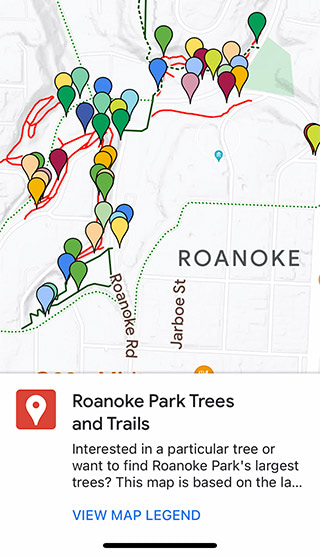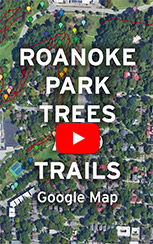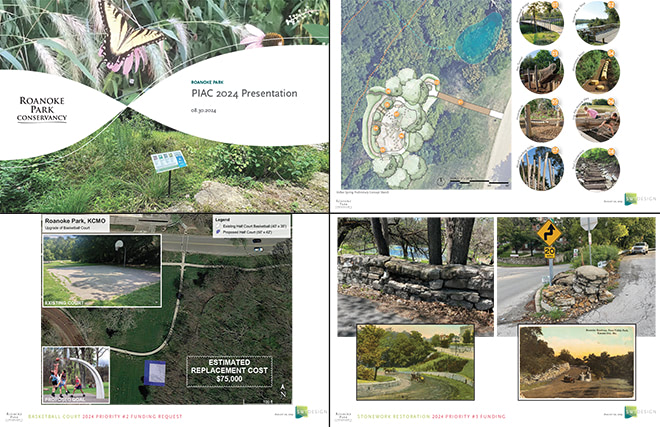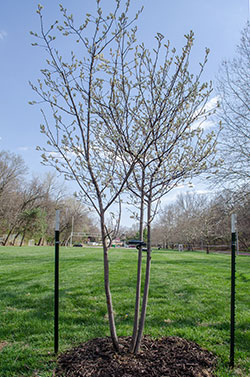2024 PIAC - Nature Playground, Basketball, Stone Restoration
2024 PIAC Submission: Nature Playground, Basketball Court, Stone Restoration

Since it was founded the Roanoke Park Conservancy has worked with the parks department to seek PIAC funding for improvements throughout the park with great success. These requests have aligned with the 2011 Master Plan, and benefited from the strong support of nearby neighborhood associations.
The focus of the past few years has been improving the "south meadow," the lobe of the park southwest of the community center. These improvements include: renewing the tennis courts, new sidewalks, additional lighting, and entry pillars and signage. The Conservancy has been working with the parks department to provide design intent drawings for the many south meadow projects which have received funding. With that in hand, they will be able to put projects out to bid with more accuracy and fidelity to the intentions of the original PIAC requests. See our 2022 PIAC article for an explanation of the South Meadow elements.
Our 2024 PIAC request included:
Volker Spring Nature Playground. Providing natural enhancements and outdoor play experiences on the west side of the park. Currently, the area lacks activities outside of a lone swing, nature trails, and winter sledding. We proposed the addition of a boardwalk leading from Karnes to a spring overlook, then to a naturally flat area where a nature playground could be constructed. Log scrambles, boulders, net climbers, and stumps could entertain kids while surrounding hammocks and seating could accommodate caretakers and everyone else wanting to enjoy the health benefits of nature. The "naturally flat area" is above the runout of the winter sledding. This area is accessible from the Volker neighborhood via the trail entrance off Wyoming or the Park Court staircase.
Basketball Court. The well-used court southeast of the volleyball court is in need of a refresh. We requested a slightly larger footprint for a half court and a higher strength goal for longevity's sake. The current court is apparently asphalt and cracking at the edges. Sports court surfacing matching the tennis/pickleball courts was requested.
Stone Wall / Pillar Restoration. Stone is an integral part of Roanoke Park's charm – both its natural stone bluffs and historic masonry walls and pillars. Historic photographs of these stone walls and pillars show the appreciation of these elements decades ago. However recent decades have seen an insuffient level of maintenance and a recent instance of vehicle damage. If left to further deteriorate they will only get more costly to repair or slowly disappear over time.
Click the images below for pdfs of the 2024 request.
Roanoke Park Trees and Trails
 Click for the Roanoke Park Trees and Trails Google MapExplore Roanoke Park’s trails and help find the biggest trees in the park!
Click for the Roanoke Park Trees and Trails Google MapExplore Roanoke Park’s trails and help find the biggest trees in the park!
Roanoke Park's volunteer naturalist Chris DeLong has combined data from the 2012 tree inventory with lots of on-the-ground scouting to produce a custom Google Map you can use to explore the park. The trail paths on this map are more accurate and complete than can be found anywhere else. Markers for the park’s largest trees and others have been added to the map with each containing ID and info in a popup. Links to Missouri Botanical Garden pages are included (but are only clickable on desktop browsers).
Enjoy the trails and go find those trees!
Roanoke Park Trees and Trails
https://maps.app.goo.gl/h3p9QqMunanr4CVq5?g_st=ic
You can help improve this map by finding the trees and emailing Chris at This email address is being protected from spambots. You need JavaScript enabled to view it. with discrepancies. Some of the 2012 champions may have fallen down, or were misidentified initially. While the 2012 Tree Inventory was a snapshot in time, we’ll try to continually update this map with your help.
 Click for a video explaining Roanoke Park Trees and TrailsEven in just the process of rolling out this map several corrections and discoveries have been made. The 2012 second place chinkapin oak is now the park champion, after the former champ apparently got hit by lightning. Yikes! (It looks like it is trying to survive, despite dead stripes down two sides.) The old champ is west of Karnes, and the new champ is by the paw paw patch above the brick road, right above the lower trail. Also it looks like we have a kind of Hickory tree we didn't know about. The champion "hickory" in 2012 appears to be a Shellbark Hickory, Carya laciniosa. That species is also called Kingnut, for having the largest of all hickory nuts. We'll try to beat the critters to some to help confirm the identification.
Click for a video explaining Roanoke Park Trees and TrailsEven in just the process of rolling out this map several corrections and discoveries have been made. The 2012 second place chinkapin oak is now the park champion, after the former champ apparently got hit by lightning. Yikes! (It looks like it is trying to survive, despite dead stripes down two sides.) The old champ is west of Karnes, and the new champ is by the paw paw patch above the brick road, right above the lower trail. Also it looks like we have a kind of Hickory tree we didn't know about. The champion "hickory" in 2012 appears to be a Shellbark Hickory, Carya laciniosa. That species is also called Kingnut, for having the largest of all hickory nuts. We'll try to beat the critters to some to help confirm the identification.
You could also add tree observations to iNaturalist if good ID pictures can be taken, adding to our Roanoke Park Biodiversity Project: inaturalist.org/projects/roanoke-park-biodiversity What are good ID pictures? More than one, clear and hopefully focussing on distinguising characteristics: the "key things" that separate a tree species from close relatives. If you don't know and are learning, take a variety! iNaturalist lets you upload four photos initially, but then you can keep hitting the + icon and adding more. Bark, leaves, flowers, fruit or seeds, twigs, winter buds - all can show useful ID characters.
Honoring Judy Widener
In memory of Judy Widener, founder of Dance in the Park
A native serviceberry memorial tree was planted in the spring of 2018 by the parks department within view of the current location of Dance in the Park. Enjoy the blooms it has in spring and its elegance in all seasons, and give thanks for neighbors who add beauty and life to the park. A multi-trunked serviceberry was chosen for it's delicate features. Can a tree dance?
(2018's drought conditions haven't been kind to this new tree but we believe it will bounce back.)
Here's a memorial page from Bridging the Gap with more information about Judy.
Roanoke Park News & Events
TRAIL INFO
Trail Maps, in various formats:
Roanoke_Park_Trails.pdf (417 kb).
Roanoke Park Trees and Trails Google Map
"Roanoke Park Tour" on MTBProject.com
To avoid damaging trails, check Trail Status before biking or hiking off road. ("Rozarks" = Roanoke Park's 2.5 miles plus Rosedale's 3.5 miles.)
Contact the Westport-Roanoke Community Center to find out about their facilities or inquire about reserving spaces.



